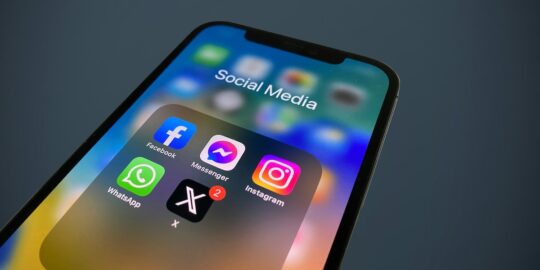
Is your school district upgrading its existing interactive flat panels or switching to an alternative? As an IT administrator, implementing new interactive flat panels in the classroom can mean training educators in a new user interface (UI), converting files for use with a new display, and an influx of helpdesk tickets from confused educators. Implementing a flat panel alternative with a simple UI and unparalleled compatibility can help your district save money and prevent frustration for IT.
Technology guides education in the modern classroom, introducing educators to new teaching methods, encouraging social collaboration, and increasing classroom engagement. School districts invest in new technology to build a social and interactive classroom, helping educators enhance their lesson plans and make the classroom more accessible. Incorporating interactive videos into classroom lessons nearly doubles student achievement and satisfaction, making interactive flat panels an obvious choice for most districts.
Your school district may have purchased interactive flat panels or whiteboards several years ago and been discouraged by the training required to implement the technology. Before your school district decides to replace its aging displays, consider an easy-to-integrate alternative to reduce your helpdesk tickets and pre-rollout training.
Why School Districts Invest In Interactive Flat Panels Instead of an Interactive Flat Panel Alternative
When school districts invest in technology to excite students and enhance the learning experience, interactive flat panels have been a go-to solution for over a decade. Interactive flat panel alternatives have not gained traction until recent years, but why do many school districts prefer to stick with their existing solutions?
Interactive flat panels are a clear path for many school districts to meet the following objectives in the classroom:
- Encourage student interaction and engagement
- An exciting and collaborative tool for educators
- Improves flexibility to suit diverse learning styles
- SMART or internet-enabled displays improve classroom accessibility to web-based content
- Smaller footprint and lower energy consumption than older projectors and interactive whiteboards
How Interactive Flat Panels Sometimes Fail to Meet the Expectations of School Districts
School districts that invest in interactive flat panels experience a spike in student engagement. However, student interest can wane when teachers are not well trained in using the interactive flat panel to create a collaborative experience. Your school may have invested in interactive displays a decade ago when the technology was relatively new. Still, aging flat panels can negatively impact the classroom experience. An alternative to interactive flat panels can bring new life to the technology in the classroom, re-igniting student engagement with new approaches to using the display.
Interactive flat panels can also impact district IT departments. Their complexity and feature-rich designs can require extensive training. Educators may need training from connecting the HDMI cable to their laptops to launching interactive games and browsing popular educational websites.
Interactive displays can be part of a closed ecosystem, limiting compatibility with devices, file types, and software students and educators use in the classroom. For example, the display may support the teacher’s PC running Windows 10 but refuse to connect to a student’s Chromebook or iPad. Each flat panel will need at least an HDMI cable to connect to devices, and users will need to be within range of the cable or use an unreliable screencasting application.
When your school district procures several hundred interactive flat panels, installing the new panels and disposing of the outdated panels can take weeks of resources from IT. The unfamiliar technology can cause an increase in helpdesk tickets and may also require frequent HDMI and A/V cable replacements and updates for the foreseeable future.
How Alternative Interactive Display Technology Improves the Classroom Social Experience
You can save your district time, money, and resources by switching to an alternative display technology that complements your current displays instead of purchasing a fleet of updated interactive flat panels. Wireless screen mirroring is an interactive flat panel alternative that supplements your existing flat panels with a refreshing learning experience. The solution works with other displays your school district may already use, such as HDTVs and projectors.
Wireless screen mirroring is a full-featured, software-agnostic, and highly compatible solution. It can replace your district’s interactive whiteboards (when paired with an HD display) or work alongside its interactive flat panels. Educators want interactive display technology that keeps up with current pedagogy, demanding more social features, interactive applications, or a more intuitive UI to enhance their lesson plans.
Wireless screen mirroring is an interactive flat panel alternative that allows the teacher and students to wirelessly connect to a display from any connected device, sharing their screen in a way that does not limit mobility and allows for a social classroom experience. Wireless screen mirroring devices are inexpensive and offer plug-and-play compatibility with your school district’s existing displays.
Related: Collaborative Technology Tools for Students: A World of Possibilities
The Benefits of Wireless Screen Mirroring
Wireless screen mirroring solutions are an inexpensive and easy-to-integrate alternative to interactive flat panels. They fulfill the objective school districts attempt to satisfy with interactive flat panels, increasing student interaction, engagement, and excitement while encouraging a social and collaborative classroom. Educators appreciate the ease of use, flexibility, and freedom of movement that wireless screen mirroring provides in the classroom.
Wireless screen mirroring solutions provide the following advantages:
- A simple plug-and-play installation
- It works with existing displays (HD display, interactive flat panel, projector) and devices
- Connects to any device with wireless capability to share screen content on a display
- The intuitive UI will be familiar to any teacher that has used an Apple TV or SMART TV
- The software agnostic system works with any software and file types on a device
- IT can simplify updates and access control from a central point
- Administrators can display announcements and welcome messages district or campuswide
- The technology is energy-efficient and eliminates the need for replacement cables
- Uses minimal Wi-Fi bandwidth to mirror displays wirelessly in high-resolution
- Access to the display is secure and allows between one and four students to share their screens with permission
Considerations When Making the Switch to Wireless Screen Mirroring
Wireless screen mirroring can be an excellent alternative to new interactive flat panels. When choosing a wireless screen mirroring solution for your district, there are several considerations.
Integration
Installing a wireless screen mirroring system can be as simple as plug-and-play if your district already has a conducive classroom environment. The classroom will need an internet connection, a power source for the device, and a display (even an existing interactive flat panel). As an IT administrator, the ease of integration makes wireless screen mirroring an enticing option. Wireless screen mirroring can be a time and cost-efficient way to extend the lifecycle of existing display technology in your school district.
Wireless screen mirroring is optimal for technology-enabled active learning (TEAL) spaces and modular classrooms. They take up little space and scale with the number of students and devices in the school. Wireless screen mirroring also works with new software or devices.
Accessibility
Wireless screen mirroring improves accessibility by allowing teachers and students to connect to the display and share their screens wirelessly. The best wireless screen mirroring solutions permit a teacher and several students (with the teacher’s permission) to connect to the display simultaneously for seamless collaboration. Wireless screen mirroring solutions also allow the students to see the same content on the main display from their devices, allowing them to take home content for note-taking, study, and inspiration.
Security can be a concern for district IT departments. Look for a wireless screen mirroring solution that offers access control and configuration from a centralized database using SAML or LDAP. Centralized control also permits district IT to relay announcements and other messages to displays and digital signage on campus, improving districtwide communications.
Educational Features
Many interactive flat panels and alternatives are not designed for educational purposes. While educational solutions are a large share of the interactive flat panel market, interactive flat panels and alternatives share the market with the business sector for training and presentation purposes. Make sure the technology you select is equipped for the educational environment. Several wireless screen mirroring solutions are on the market, but only a handful are made for education.
Wireless screen mirroring technology is ideal for the classroom, allowing users to interact with the display from anywhere in the room. Since wireless technology is integrated into nearly every IoT device for education, wireless screen mirroring offers long-term compatibility with new devices introduced into the classroom.
Related: 6 things to think about when designing your TEAL space
An Interactive Flat Panel Alternative: Create a Social Classroom With Wireless Screen Mirroring
Many school districts are looking to update their existing interactive flat panels or invest in interactive display technology to engage students and build a social classroom. Wireless screen mirroring is an interactive flat panel alternative that will satisfy teachers and students while making integration simple and efficient for the district IT department.
Vivi is a wireless screen mirroring solution for education that allows the teacher and up to four students to share their screen wirelessly on the main display. Vivi is convenient and secure, allowing district IT to configure and control a single or thousands of displays from a single user database. Book a demo with Vivi to see if wireless screen mirroring is suitable for your school district.



